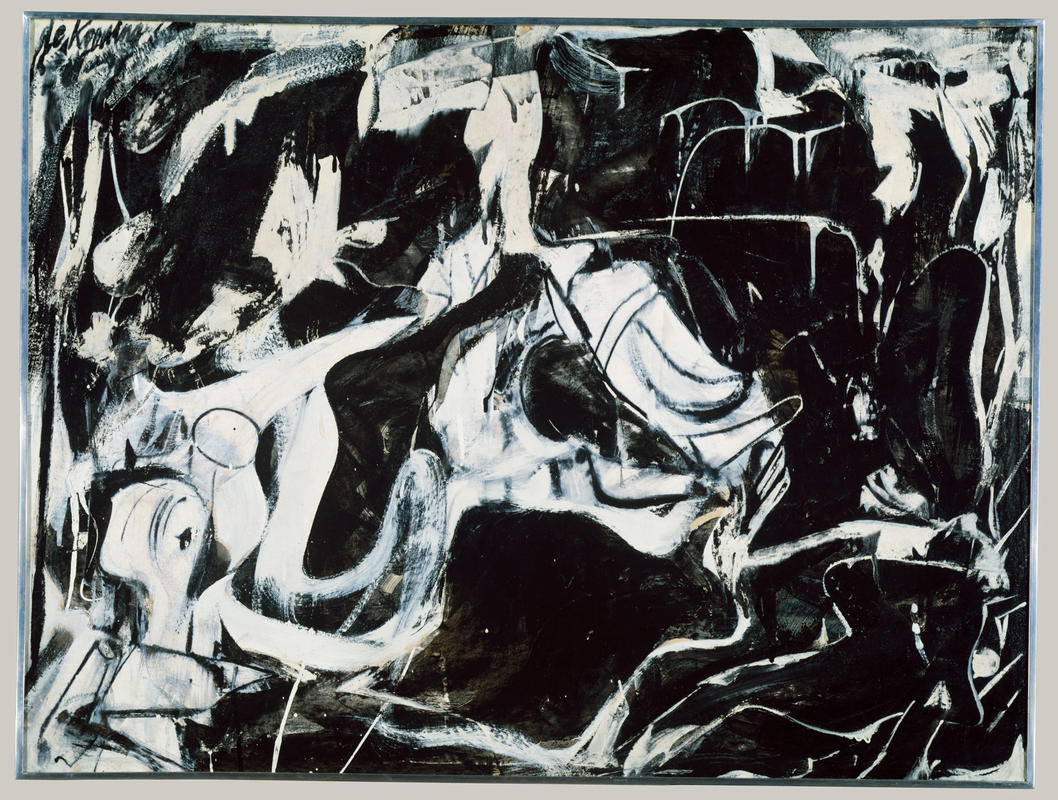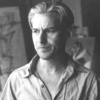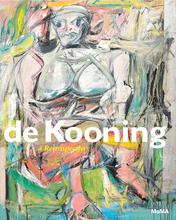More about Black Untitled
- All
- Info
- Shop

Sr. Contributor
Black Untitled isn’t your average de Kooning, but it does reveal the beginnings of an illustrious career in the mid-century New York art scene.
Although this painting might not feature a terrifying woman, the human figure is just below the surface of the patches of black and white that dance across this canvas. Like his friend and fellow artist Arshile Gorky, figures remained central to de Kooning’s work, even if we think of him as an abstract artist.
This early example of de Kooning’s brand of abstraction is characteristic of his difficult first years as an artist. Early on, de Kooning worked in black and white commercial enamel paint simply because he was broke. As a Federal Art Project employee, de Kooning was only making a little over twenty dollars per week and picked up odd jobs for additional money. He needed a lot of paint, and he needed to buy it cheaply.
Despite his starving artist status, de Kooning continued to work hard. His signature melding of representation and abstraction took a while to finesse, and he was fine with that. You see, de Kooning was a bit of a late bloomer; whereas Jackson Pollock’s explosive life ended at age 44, this was exactly how old de Kooning was when he finally mounted his first show. But this actually wasn’t de Kooning’s first chance at a solo exhibition. A few years earlier, he had done the unthinkable: he refused an invitation to show his paintings at Peggy Guggenheim’s infamous gallery Art of This Century. Although Peggy Guggenheim was known for showing the best in modern and contemporary art, de Kooning didn’t jive with the dealer’s circle of chosen artist friends. He also wanted more time to perfect his newly-found style. After a few years, de Kooning was ready to make his big break.
This early example of de Kooning’s abstract work debuted in 1948 at the Charles Egan Gallery in New York, along with nine other black and white abstract paintings. The artist’s first solo exhibition finally happened twenty-two years after he moved to the United States from the Netherlands. But de Kooning’s debut was well worth the wait. Egan was known for exhibiting the works of Isamu Noguchi, Franz Kline, and Philip Guston. Later in 1955, the Charles Egan Gallery was also where Robert Rauschenberg’s Bed and other Combine paintings debuted.
Despite the gallery’s status, no paintings sold for the duration of the show. Egan extended the show for an extra month, and the Museum of Modern Art purchased one of de Kooning’s black and white paintings for a mere $700. With one painting already in MoMA’s already impressive collection, de Kooning soon sold another of these paintings to Thomas Hess, who was definitely a good guy to have on his side. Hess was an art critic, longtime editor of the acclaimed Art News magazine, and chairman of the Department of Twentieth-Century Art at The Metropolitan Museum of Art, even though he only worked for the Museum for five months before dying of a heart attack that happened right at his desk. Before his death, however, Hess devoted himself to such artists as de Kooning and Barnett Newman, helping them rise to the heroic status they still enjoy today.
Sources
- Fineberg, Jonathan. Art Since 1940: Strategies of Being. 3rd edition. Upper Saddle River, NJ: Pearson Education, Inc., 2011.
- Gompertz, Will. What Are You Looking At? New York: The Penguin Group, 2012.
- Lambert, Bruce. “Charles Egan, 81; Art Gallery Owner Helped de Kooning.” The New York Times. March 18, 1993. http://www.nytimes.com/1993/03/18/obituaries/charles-egan-81-art-galler…. Accessed January 29, 2018.
- Russell, John. “Thomas Hess, Art Expert, Dies; Writer and Met Official was 57.” The New York Times. July 14, 1978. http://www.nytimes.com/1978/07/14/archives/thomas-hess-art-expert-dies-…. Accessed January 29, 2018.
- The Art Story. “Charles Egan Gallery.” http://www.theartstory.org/gallery-egan-charles.htm. Accessed January 29, 2018.
- The Metropolitan Museum of Art. “Black Untitled.” Collection. https://www.metmuseum.org/art/collection/search/483878, Accessed January 29, 2018.












